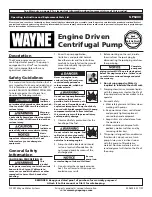
3
WARNING
!
Operating Hazards
•
The use this too can expose the operator’s hands to
hazards including, impacts, cuts and abrasions and heat.
Wear suitable gloves to protect hands.
•
Operators and maintenance personnel shall be physically
able to handle the bulk, weight and power of the tool.
•
Hold the tool correctly; be ready to counteract normal or
sudden movements and have both hands available.
•
Maintain a balanced body position and secure footing.
•
In cases where the means to absorb the reaction torque
are requested, it is recommended to use a suspension
arm whenever possible. If that is not possible, side
handles are recommended for straight-case and pistol-
grip tools. It is recommended to use a means to absorb
the Reaction torque above 2.95 ft.-lbs. (4 N•m) for straight
tools, above 7.38 ft.-lbs. (10 N•m) for pistol-grip tools.
•
Release the start-and-stop device in the case of an
interruption of the energy supply.
•
Do not use in confined spaces and beware of crushing
hands between tool and workpiece
Workplace Hazards
•
Slips, trips and major causes of workplace injury. Be
aware of slippery surfaces caused by the use of the
tool and also of trip hazards caused by the air line or
hydraulic hose.
•
Proceed with care in unfamiliar surroundings. Hidden
hazards, such as electricity or other utility lines, can exist.
•
The impact wrench is not intended for use in potentially
explosive atmospheres and is not insulated against
coming into contact with electric power.
•
Make sure there are no electrical cables, gas pipes, etc.,
that can cause a hazard if damaged by use of the tool.
•
Dust and fumes generated when using impact wrench
can cause ill health (for example cancer, birth defects,
asthma and/or dermatitis); risk assessment and
implementation of appropriate controls for these hazards
are essential.
•
Direct the exhaust so as to minimize disturbance of dust
in a dust-filled environment.
•
Use respiratory protection in accordance with employer’s
instructions and as required by occupational health and
safety regulations.
Projectile Hazards
•
Failure of the workpiece,of accessories or even of the
inserted tool itself can generate high-velocity projectiles.
•
Always wear impact-resistant eye protection during the
operation of the impact wrench. The grade of protection
required should be assessed for each use.
•
Ensure that the workpiece is securely fixed.
Entanglement Hazards
•
Entanglement hazards can result in choking, scalping
and/or lacerations if loose clothing, personal jewelery,
neckware, hair or gloves are not kept away from the tool
and accessories.
•
Gloves can become entangled with the rotating drive,
causing severed or broken fingers.
•
Rotating drive sockets and drive extensions can easily
entangle rubber-coated or metal-reinforced gloves.
•
Do not wear loose-fitting gloves with cut of frayed fingers.
•
Never hold the drive, socket or drive extension.
•
Keep hands away from rotating drives.
Noise Hazards
•
Exposure to high noise levels can cause permanent,
disabling loss and other problems, such as tinnitus
(ringing, buzzing, whistling or humming in the ears).
Therefore a risk assessment and implementation of
appropriate controls for these hazards are essential.
•
Appropriate controls to reduce the risk may include
actions such as damping materials to prevent
workpieces from “ringing”.
•
Use hearing protection in accordance with employer’s
instructions and as required by occupational health and
safety regulations.
•
Operate and maintain the impact wrench as
recommended in the instructions handbook, to prevent
an unnecessary increase in noise levels.
•
Select, maintain and replace the consumable/inserted
tool as recommended in the instructions handbook, to
prevent an unnecessary increase in noise.
Vibration Hazards
•
Exposure to vibration can cause disabling damage to the
nerves and blood supply of the hands and arms.
•
Wear warm clothing when working in cold conditions and
keep your hands warm and dry.
•
If you experience numbness, tingling, pain or whitening
of the skin in your fingers or hands, stop using the impact
wrench, tell your employer and consult a physician.
•
Operate and maintain the impact wrench as recommended
in the instructions handbook, to prevent an unnecessary
increase in vibration levels.
•
Do not use worn or ill-fitting sockets or extensions, as this
is likely to cause a substantial increase in vibration.
•
Hold the tool with a light but safe grip, taking account of
the required hand reaction forces, because the risk from
vibration is generally greater when the grip force is higher.
•
Support the weight of the tool in a stand, tensioner or
balancer, if possible.
•
Sleeve fittings should be used where practicable.
Repetitive Motion Hazards
•
If the operator experiences symptoms such as
persistent or recurring discomfort, pain, throbbing,
aching, tingling, numbness, burning sensations or
stiffness, these warning signs should not be ignored.
The operator should cease use of the tool, tell the
employer and consult a qualified health professional.
Maintenance Hazards
•
Disconnect air hose from tool prior to any maintenance
work.


























